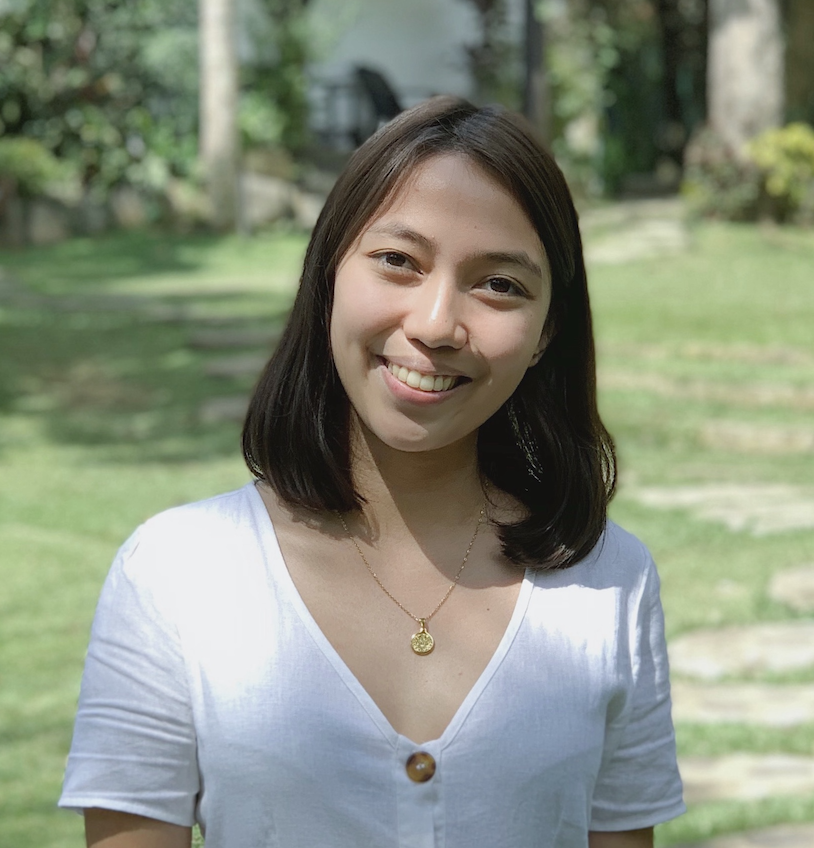Machine Learning Identifies Top Predictors of Suicide Attempts
Overview
This was a final project output for our Machine Learning course under Prof. Chris Monterola in the M.Sc. Data Science program. This study confirms that machine learning can be used on mental health data (if made available). It is capable of identifying predictors of suicide attempts and other critical suicide risk such as self-harm. This was presented to class in August 2019.

Identifying Suicide Attempt Predictors using Machine Learning
An extended study
Prepared by Bengielyn Danao
Executive Summary
Suicide and suicide attempts are very challenging to predict because it is an end result of complex social, psychological, and biological interactions. Statistically speaking, it is also rare in terms of reported instances. Machine learning is now put forward as a tool that could improve the accuracy of predicting suicide and its predictors. An existing study from the Department of Psychiatry, University of Texas Health Science Center used information from 144 subjects and got an accuracy of 72%. Similarly, this study has used demographic data from a survey of 496 respondents. Using the Random Forest Classifier, an accuracy of 81% has been obtained and the model identified depression as the highest predictor of suicide attempts.
Data Source
The demographic data was collected from a survey of subscribers of the subreddit /r/ForeverAlone. The survey questions served as the variables and are listed below:
- Gender (male of female)
- Sexual orientation (bisexual, lesbian, gay)
- Age
- Income level
- Race / ethnicity
- Bodyweight description (underweight, normal, overweight, obese)
- Virginity (yes / no)
- Legality of prostitution in the area (yes / no)
- No. of friends in real life
- Social fear / anxiety (yes / no)
- Are you depressed? (yes / no)
- What kind of help do you want from others? (string)
- Have you attempted suicide? (yes / no)
- Employment status (undemployed, employed, student)
- Job title (string)
- Education level
- What have you done to improve yourself? (string)
There were a total of 496 user participants of this survey and the dataset is available in Kaggle or in this link.
Sample data
| time | gender | sexuallity | age | income | race | bodyweight | virgin | prostitution_legal | pay_for_sex | friends | social_fear | depressed | what_help_from_others | attempt_suicide | employment | job_title | edu_level | improve_yourself_how | |
|---|---|---|---|---|---|---|---|---|---|---|---|---|---|---|---|---|---|---|---|
| 0 | 5/17/2016 20:04:18 | Male | Straight | 35 | $30,000 to $39,999 | White non-Hispanic | Normal weight | Yes | No | No | 0.0 | Yes | Yes | wingman/wingwoman, Set me up with a date | Yes | Employed for wages | mechanical drafter | Associate degree | None |
| 1 | 5/17/2016 20:04:30 | Male | Bisexual | 21 | $1 to $10,000 | White non-Hispanic | Underweight | Yes | No | No | 0.0 | Yes | Yes | wingman/wingwoman, Set me up with a date, date... | No | Out of work and looking for work | - | Some college, no degree | join clubs/socual clubs/meet ups |
| 2 | 5/17/2016 20:04:58 | Male | Straight | 22 | $0 | White non-Hispanic | Overweight | Yes | No | No | 10.0 | Yes | Yes | I don't want help | No | Out of work but not currently looking for work | unemployed | Some college, no degree | Other exercise |
| 3 | 5/17/2016 20:08:01 | Male | Straight | 19 | $1 to $10,000 | White non-Hispanic | Overweight | Yes | Yes | No | 8.0 | Yes | Yes | date coaching | No | A student | student | Some college, no degree | Joined a gym/go to the gym |
| 4 | 5/17/2016 20:08:04 | Male | Straight | 23 | $30,000 to $39,999 | White non-Hispanic | Overweight | No | No | Yes and I have | 10.0 | No | Yes | I don't want help | No | Employed for wages | Factory worker | High school graduate, diploma or the equivalen... | None |
Data Cleaning
Columns that were not deemed determinate of the target variable (suicide attempt) were dropped and column names were renamed as needed.
drop_col = ['time', 'prostitution_legal', 'pay_for_sex', 'job_title']
clean_dum = dummy.drop(drop_col, axis=1)
clean_dum = clean_dum.rename(columns={'sexuallity':'sexuality', 'friends':'# of friends', 'what_help_from_others':'want_help', 'edu_level':'education', 'improve_yourself_how':'willing_to_improve'})
The variable "what help from others" was also changed to binary. The phrase "I don't want help" was filtered and was categorized as a negative outcome (non-help) and all the rest be positive outcomes. The same was done for the column "improve yourself how" using the keyword "None" to identify negative outcomes and all the rest as positive outcomes.
clean_dum['willing_to_improve'] = clean_dum['willing_to_improve'].str.lower()
clean_dum.loc[clean_dum['willing_to_improve'] == 'none', 'willing_to_improve'] = 0
clean_dum.loc[clean_dum['willing_to_improve'] != 0, 'willing_to_improve'] = 1
clean_dum['want_help'] = clean_dum['want_help'].str.lower()
no_list = ["i don't want help", 'im on my own',
'there is no way that they can help. they only give useless advice like "just be more confident".',
"i don't want any help. i can't even talk about it.",
"i don't want help, like, to be seen & treated like a normal person",
'i lost faith and hope', "i don't want help, kill me", "i don't want help, more general stuff"]
for item in no_list:
clean_dum.loc[clean_dum['want_help'] == item, 'want_help'] = 0
clean_dum.loc[clean_dum['want_help'] != 0, 'want_help'] = 1
The ordinal categorical variables (education, bodyweight, and income level) were mapped accordingly while the nominal categorical variables were also regrouped as shown below then one-hot encoded as necessary.
clean_dum['education'] = clean_dum['education'].str.lower()
clean_dum['gender'] = clean_dum['gender'].str.lower()
clean_dum['sexuality'] = clean_dum['sexuality'].str.lower()
clean_dum['race'] = clean_dum['race'].str.lower()
clean_dum['bodyweight'] = clean_dum['bodyweight'].str.lower()
clean_dum['employment'] = clean_dum['employment'].str.lower()
hs = ['high school graduate, diploma or the equivalent (for example: ged)', 'trade/technical/vocational training',
'some high school, no diploma']
college = ['associate degree', 'some college, no degree', 'bachelor’s degree', ]
post_grad = ["master’s degree", 'doctorate degree', 'professional degree']
for deg in hs:
clean_dum.loc[clean_dum['education'] == deg, 'education'] = 1
for deg in college:
clean_dum.loc[clean_dum['education'] == deg, 'education'] = 2
for deg in post_grad:
clean_dum.loc[clean_dum['education'] == deg, 'education'] = 3
unemployed = ['out of work and looking for work', 'out of work but not currently looking for work',
'unable to work', 'retired', 'a homemaker']
employed = ['employed for wages', 'military', 'self-employed']
for x in unemployed:
clean_dum.loc[clean_dum['employment'] == x, 'employment'] = 'unemployed'
for x in employed:
clean_dum.loc[clean_dum['employment'] == x, 'employment'] = 'employed'
clean_dum.loc[clean_dum['employment'] == 'a student', 'employment'] = 'student'
# hispanic = ['hispanic (of any race)']
european = ['caucasian', 'turkish', 'european']
# asian = ['asian']
# indian = ['indian']
african = ['black', 'north african']
mixed = ['mixed race', 'helicopterkin', 'mixed', 'multi', 'white non-hispanic',
'white and asian', 'mixed white/asian', 'half asian half white',
'first two answers. gender is androgyne, not male; sexuality is asexual, not bi.']
american = ['native american', 'native american mix', 'white and native american']
middle_eastern = ['middle eastern', 'half arab', 'pakistani']
for val in european:
clean_dum.loc[clean_dum['race'] == val, 'race'] = 'european'
for val in african:
clean_dum.loc[clean_dum['race'] == val, 'race'] = 'african'
for val in mixed:
clean_dum.loc[clean_dum['race'] == val, 'race'] = 'mixed race'
for val in american:
clean_dum.loc[clean_dum['race'] == val, 'race'] = 'american'
for val in middle_eastern:
clean_dum.loc[clean_dum['race'] == val, 'race'] = 'middle eastern'
clean_dum.loc[clean_dum['race'] == 'hispanic (of any race)', 'race'] = 'hispanic'
clean_dum.loc[clean_dum['race'] == 'asian', 'race'] = 'asian'
clean_dum.loc[clean_dum['race'] == 'indian', 'race'] = 'indian'
low = ['$1 to $10,000', '$0', '$30,000 to $39,999', '$20,000 to $29,999', '$10,000 to $19,999']
mid = ['$50,000 to $74,999', '$75,000 to $99,999', '$40,000 to $49,999']
high = ['$150,000 to $174,999', '$125,000 to $149,999', '$100,000 to $124,999', '$174,999 to $199,999',
'$200,000 or more']
for num in low:
clean_dum.loc[clean_dum['income'] == num, 'income'] = 'low'
for num in mid:
clean_dum.loc[clean_dum['income'] == num, 'income'] = 'mid'
for num in high:
clean_dum.loc[clean_dum['income'] == num, 'income'] = 'high'
clean_dum['bodyweight'] = clean_dum['bodyweight'].map(bodyweight)
clean_dum['income'] = clean_dum['income'].map(income_map)
clean_dum['virgin'] = clean_dum['virgin'].map(virgin_map)
clean_dum['social_fear'] = clean_dum['social_fear'].map(social_fear)
clean_dum['attempt_suicide'] = clean_dum['attempt_suicide'].map(suicide_attempt)
clean_dum['depressed'] = clean_dum['depressed'].map(depressed_map)
new_dummy = pd.get_dummies(clean_dum)
| age | income | bodyweight | virgin | # of friends | social_fear | depressed | want_help | attempt_suicide | education | ... | race_american | race_asian | race_european | race_hispanic | race_indian | race_middle eastern | race_mixed race | employment_employed | employment_student | employment_unemployed | |
|---|---|---|---|---|---|---|---|---|---|---|---|---|---|---|---|---|---|---|---|---|---|
| 0 | 35 | 1 | 2 | 1 | 0.0 | 1 | 1 | 1 | 1 | 2 | ... | 0 | 0 | 0 | 0 | 0 | 0 | 1 | 1 | 0 | 0 |
| 1 | 21 | 1 | 1 | 1 | 0.0 | 1 | 1 | 1 | 0 | 2 | ... | 0 | 0 | 0 | 0 | 0 | 0 | 1 | 0 | 0 | 1 |
| 2 | 22 | 1 | 3 | 1 | 10.0 | 1 | 1 | 0 | 0 | 2 | ... | 0 | 0 | 0 | 0 | 0 | 0 | 1 | 0 | 0 | 1 |
| 3 | 19 | 1 | 3 | 1 | 8.0 | 1 | 1 | 1 | 0 | 2 | ... | 0 | 0 | 0 | 0 | 0 | 0 | 1 | 0 | 1 | 0 |
| 4 | 23 | 1 | 3 | 0 | 10.0 | 0 | 1 | 0 | 0 | 1 | ... | 0 | 0 | 0 | 0 | 0 | 0 | 1 | 1 | 0 | 0 |
5 rows × 29 columns
The new_dummy is now the final, cleaned dataframe that will be used in the model. But for now, let us look more into our data.
Exploratory Data Analysis
a_ = df_drop.groupby(['gender','sexuality'])['age'].count().reset_index().pivot(columns='sexuality', index='gender')
a_.fillna(0)
fig, ax = plt.subplots(1,2, figsize=(16,7))
total = df_drop.shape[0]
sns.countplot(x='gender', data=df_drop, ax=ax[0])
ax[0].set_title('Gender Distribution')
ax[0].set_axisbelow(True)
ax[0].yaxis.set_major_formatter(mpl.ticker.StrMethodFormatter('{x:,.0f}'))
ax[0].set_ylabel('count')
# percent labels
for p in ax[0].patches:
height = p.get_height()
ax[0].text(p.get_x()+p.get_width()/2,
height + 2,
f'{height/total:.0%}',
ha="center",
weight='semibold',
fontsize=16)
total = df_drop.shape[0]
sns.countplot(x='sexuality', data=df_drop, ax=ax[1])
ax[1].set_title('Sexuality Distribution')
ax[1].set_axisbelow(True)
ax[1].yaxis.set_major_formatter(mpl.ticker.StrMethodFormatter('{x:,.0f}'))
ax[1].set_ylabel('count')
plt.tight_layout()
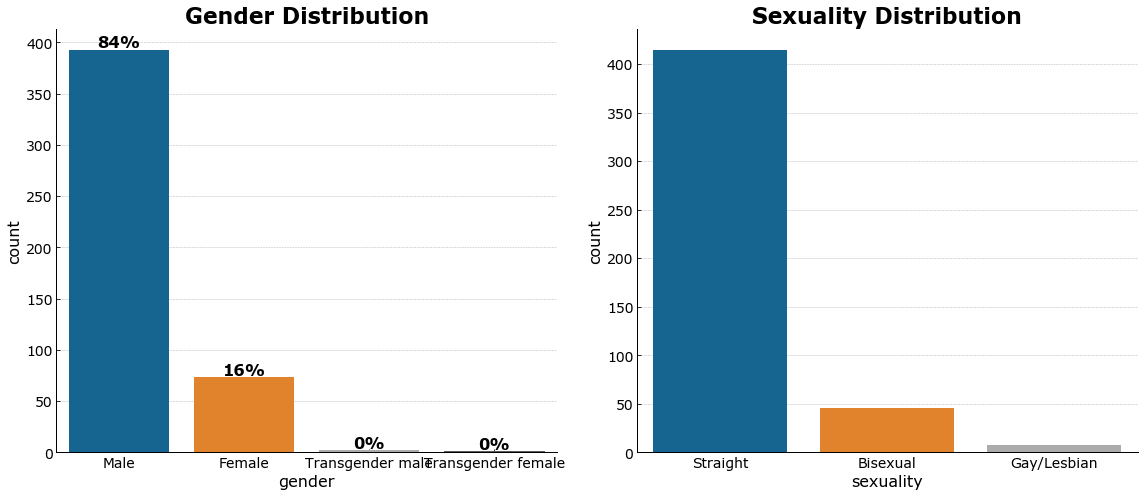
male_data = df_drop[df_drop.gender=='Male']
female_data = df_drop[df_drop.gender=='Female']
plt.figure(figsize=(10,8))
# plt.hist(df_drop['age']);
plt.hist([male_data.age, female_data.age], label=['Male', 'Female'])
plt.legend(loc='upper right')
plt.title("Age Distribution")
plt.ylabel('count of users')
plt.xlabel('age');
plt.show()

Majority of the respondents are male and straight and aged from 15-30
fig, ax = plt.subplots(1,2, figsize=(16,7))
total = df_drop.shape[0]
sns.countplot(x='willing_to_improve', data=df_drop, ax=ax[0])
ax[0].set_title('willingness to improve')
ax[0].set_axisbelow(True)
ax[0].yaxis.set_major_formatter(mpl.ticker.StrMethodFormatter('{x:,.0f}'))
ax[0].set_ylabel('count')
# percent labels
for p in ax[0].patches:
height = p.get_height()
ax[0].text(p.get_x()+p.get_width()/2,
height + 2,
f'{height/total:.0%}',
ha="center",
weight='semibold',
fontsize=16)
total = df_drop.shape[0]
sns.countplot(x='want_help', data=df_drop, ax=ax[1])
ax[1].set_title('wants help')
ax[1].set_axisbelow(True)
ax[1].yaxis.set_major_formatter(mpl.ticker.StrMethodFormatter('{x:,.0f}'))
ax[1].set_ylabel('count')
# percent labels
for p in ax[1].patches:
height = p.get_height()
ax[1].text(p.get_x()+p.get_width()/2,
height + 2,
f'{height/total:.0%}',
ha="center",
weight='semibold',
fontsize=16)
plt.tight_layout()
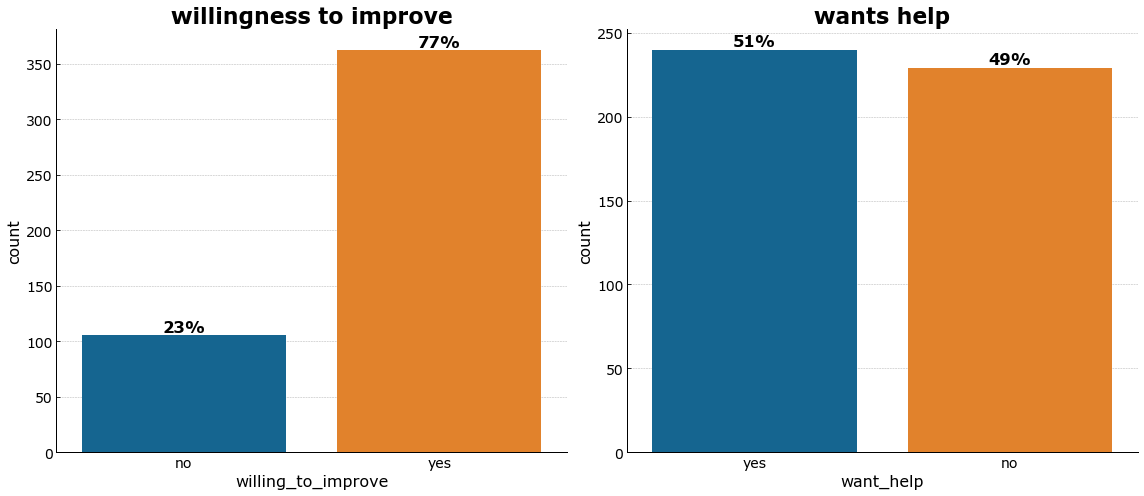
Almost half of the users say they do not want help but 70% are actually willing to improve themselves. This could imply that a significant number of them are uncomfortable of external help or reaching out to someone else.
fig, ax = plt.subplots(1,2, figsize=(16,7))
total = df_drop.shape[0]
sns.countplot(x='depressed', data=df_drop, ax=ax[0])
ax[0].set_title('depression')
ax[0].set_axisbelow(True)
ax[0].yaxis.set_major_formatter(mpl.ticker.StrMethodFormatter('{x:,.0f}'))
ax[0].set_ylabel('count')
# percent labels
for p in ax[0].patches:
height = p.get_height()
ax[0].text(p.get_x()+p.get_width()/2,
height + 2,
f'{height/total:.0%}',
ha="center",
weight='semibold',
fontsize=16)
total = df_drop.shape[0]
sns.countplot(x='social_fear', data=df_drop, ax=ax[1])
ax[1].set_title('social fear / anxiety')
ax[1].set_axisbelow(True)
ax[1].yaxis.set_major_formatter(mpl.ticker.StrMethodFormatter('{x:,.0f}'))
ax[1].set_ylabel('count')
# percent labels
for p in ax[1].patches:
height = p.get_height()
ax[1].text(p.get_x()+p.get_width()/2,
height + 2,
f'{height/total:.0%}',
ha="center",
weight='semibold',
fontsize=16)
plt.tight_layout()
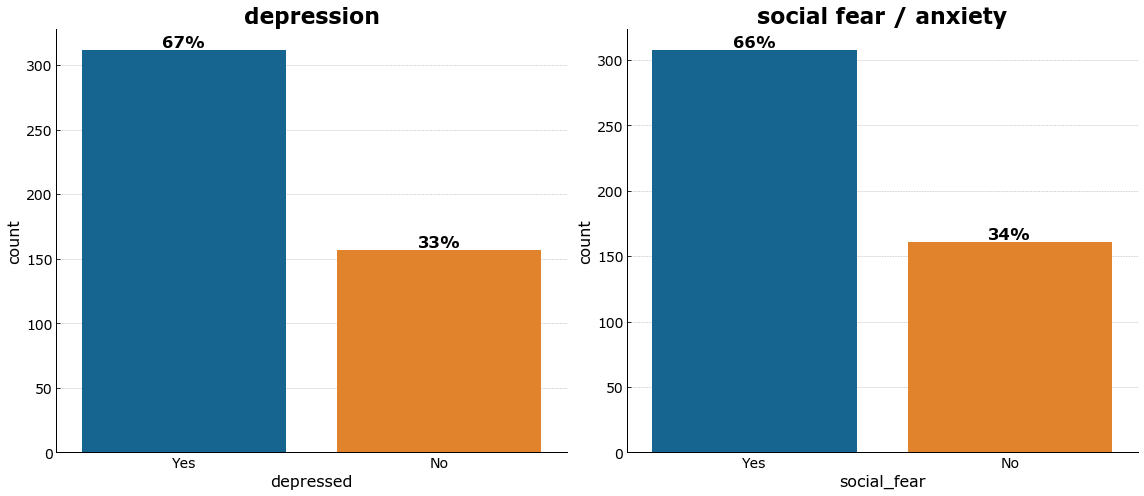
Among the participants, more than half identify themselves as depressed and with social fear - which are strong predictors of suicide attempts according to previous studies.
fig, ax = plt.subplots(1,2, figsize=(16,7))
total = df_drop.shape[0]
sns.countplot(x='education', data=df_drop, ax=ax[0])
ax[0].set_title('education')
ax[0].set_axisbelow(True)
ax[0].yaxis.set_major_formatter(mpl.ticker.StrMethodFormatter('{x:,.0f}'))
ax[0].set_ylabel('count')
# percent labels
for p in ax[0].patches:
height = p.get_height()
ax[0].text(p.get_x()+p.get_width()/2,
height + 2,
f'{height/total:.0%}',
ha="center",
weight='semibold',
fontsize=16)
total = df_drop.shape[0]
sns.countplot(x='employment', data=df_drop, ax=ax[1])
ax[1].set_title('employment')
ax[1].set_axisbelow(True)
ax[1].yaxis.set_major_formatter(mpl.ticker.StrMethodFormatter('{x:,.0f}'))
ax[1].set_ylabel('count')
# percent labels
for p in ax[1].patches:
height = p.get_height()
ax[1].text(p.get_x()+p.get_width()/2,
height + 2,
f'{height/total:.0%}',
ha="center",
weight='semibold',
fontsize=16)
plt.tight_layout()

More than 75% of the respondents are employed and studying. More than half have / are taking up college and post-graduate degrees.
fig, ax = plt.subplots(1,2, figsize=(16,7))
total = df_drop.shape[0]
sns.countplot(x='race', data=df_drop, ax=ax[0])
ax[0].set_title('race')
ax[0].set_axisbelow(True)
ax[0].yaxis.set_major_formatter(mpl.ticker.StrMethodFormatter('{x:,.0f}'))
ax[0].set_ylabel('count')
# percent labels
for p in ax[0].patches:
height = p.get_height()
ax[0].text(p.get_x()+p.get_width()/2,
height + 2,
f'{height/total:.0%}',
ha="center",
weight='semibold',
fontsize=16)
total = df_drop.shape[0]
sns.countplot(x='income', data=df_drop, ax=ax[1])
ax[1].set_title('income')
ax[1].set_axisbelow(True)
ax[1].yaxis.set_major_formatter(mpl.ticker.StrMethodFormatter('{x:,.0f}'))
ax[1].set_ylabel('count')
# percent labels
for p in ax[1].patches:
height = p.get_height()
ax[1].text(p.get_x()+p.get_width()/2,
height + 2,
f'{height/total:.0%}',
ha="center",
weight='semibold',
fontsize=16)
plt.tight_layout()
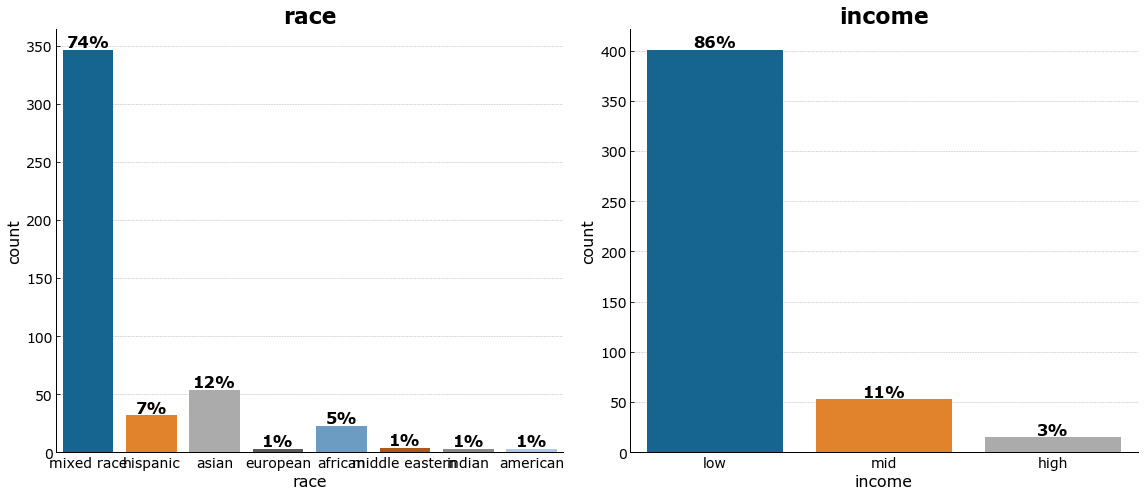
Majority of the respondents consider themselves as low income earners.
df_friend = df_drop[['# of friends', 'attempt_suicide']]
df_friend_yes = df_friend[df_friend['attempt_suicide']=='Yes']
df_friend_no = df_friend[df_friend['attempt_suicide']=='No']
df.loc[df['friends']<=50,:].groupby('attempt_suicide')['friends'].plot.hist(legend=True,
density=True);

df.groupby('social_fear')['friends'].plot.hist(legend=True)

It can be seen from the last two plots above that most people who have attempted suicide have less number of friends compared to those who don’t and people with social fear have less friends.
Now let use machine learning techniques to predict which of these variables heavily identify the likelihood of suicide attempt. Let us then pick the best technique that results in the highest accuracy.
Modelling (Classification)
from sklearn.tree import DecisionTreeClassifier
from sklearn.ensemble import RandomForestClassifier
from sklearn.ensemble import GradientBoostingClassifier
from sklearn.model_selection import train_test_split
from imblearn.over_sampling import SMOTE
from sklearn import model_selection, preprocessing
PCC
num=(new_dummy.groupby('attempt_suicide').size()/new_dummy.groupby('attempt_suicide').size().sum())**2
print("Proportion Chance Criterion = {}%".format(100*num.sum()))
print("1.25*Proportion Chance Criterion = {}%".format(1.25*100*num.sum()))
Proportion Chance Criterion = 70.3220116293343%
1.25*Proportion Chance Criterion = 87.90251453666787%
data = new_dummy.drop('attempt_suicide', axis=1)
y = new_dummy['attempt_suicide']
Let us now divide our dataset into training and test set with the attempted suicide as target label and using 15 features.
X_train, X_test, y_train, y_test = train_test_split(data, y, test_size=0.25, random_state=143)
It can be observed that our data is significantly unbalanced to non-attempts (at 80-20). This means that this class has more observations than the other one and could result in a bias prediction.
new_dummy['attempt_suicide'].value_counts()
0 384
1 85
Name: attempt_suicide, dtype: int64
So we oversample the unbalanced data using SMOTE which generate synthetic data points based on the existing dataset.
df_oversampled = SMOTE(random_state=1136)
X_res, y_res = df_oversampled.fit_resample(X_train, y_train)
Using GridSearch
The best model and hyperparameters were looked into using GridSearch.
import time
from sklearn.neighbors import KNeighborsClassifier
from sklearn.linear_model import LogisticRegression
from sklearn.svm import LinearSVC
from sklearn.svm import SVC
from sklearn.naive_bayes import GaussianNB
knn = KNeighborsClassifier(n_jobs=-1)
logres1 = LogisticRegression(penalty='l1', max_iter=1000,
solver='liblinear', n_jobs=-1)
logres2 = LogisticRegression(penalty='l2', max_iter=1000, n_jobs=-1)
linsvc1 = LinearSVC(penalty='l1', dual=False, max_iter=10000)
linsvc2 = LinearSVC(penalty='l2', max_iter=10000)
svc_rbf = SVC(kernel='rbf')
svc_poly = SVC(kernel='poly', degree=3)
dectree = DecisionTreeClassifier()
ranfor = RandomForestClassifier()
gradboost = GradientBoostingClassifier()
kneighbors = range(1, 31)
C_list = np.logspace(-5, 5, num=10)
gamma_list = np.logspace(-5, 5, num=10)
depth_list = range(3,10)
learn_rate = np.logspace(-2, 0.5, num=10)
est_list = [150, 250, 350, 550, 750]
min_samples_leaf = [2, 3, 4]
max_features = [.5, .3, .2]
classifiers = [('kNN', knn, {'n_neighbors':kneighbors}),
('Logistic Regression (L1)', logres1, {'C':C_list}),
('Logistic Regression (L2)', logres2, {'C':C_list}),
('Linear SVM (L1)', linsvc1, {'C':C_list}),
('Linear SVM (L2)', linsvc2, {'C':C_list}),
('NonLinear SVM (RBF)', svc_rbf, {'C':C_list, 'gamma':gamma_list}),
('Decision Tree (DT)', dectree, {'max_depth':depth_list}),
('Random Forest (RF)', ranfor, {'max_depth':depth_list, 'n_estimators':est_list}),
('Gradient Boosting (GBM)', gradboost, {'max_depth':depth_list, 'learning_rate':learn_rate})
]
models = {}
for cls in classifiers:
gs_cv = model_selection.GridSearchCV(cls[1], param_grid=cls[2], n_jobs=-1, scoring='accuracy')
gs_cv.fit(X_res, y_res)
models[cls[0]] = gs_cv
cols = ['Machine Learning Method', 'Test Accuracy',
'Best Parameter', 'Top Predictor Variable']
df_results = pd.DataFrame(columns=cols)
for i, m in enumerate(models):
try:
top_predictor = data.columns[
np.argmax(np.abs(models[m].best_estimator_.coef_))]
except AttributeError:
top_predictor = np.nan
df_results.loc[i] = [m,
models[m].best_estimator_.score(X_test, y_test),
models[m].best_params_ ,
top_predictor]
df_results
| Machine Learning Method | Test Accuracy | Best Parameter | Top Predictor Variable | |
|---|---|---|---|---|
| 0 | kNN | 0.703390 | {'n_neighbors': 2} | NaN |
| 1 | Logistic Regression (L1) | 0.694915 | {'C': 599.4842503189421} | race_american |
| 2 | Logistic Regression (L2) | 0.694915 | {'C': 7742.636826811277} | race_american |
| 3 | Linear SVM (L1) | 0.694915 | {'C': 3.593813663804626} | race_american |
| 4 | Linear SVM (L2) | 0.703390 | {'C': 0.2782559402207126} | race_middle eastern |
| 5 | NonLinear SVM (RBF) | 0.771186 | {'C': 3.593813663804626, 'gamma': 0.2782559402... | NaN |
| 6 | Decision Tree (DT) | 0.728814 | {'max_depth': 7} | NaN |
| 7 | Random Forest (RF) | 0.805085 | {'max_depth': 7, 'n_estimators': 150} | NaN |
| 8 | Gradient Boosting (GBM) | 0.805085 | {'learning_rate': 0.03593813663804628, 'max_de... | NaN |
Random Forest Classifier
This model is actually a powerful one as it uses many decision trees to make a prediction. These individual decision trees are uncorrelated and spits out a prediction each. The prediction with the most “votes” will then be the final prediction of the Random Forest model. This is conceptually great by the notion of wisdom of crowds. The individual decision trees “protect” themselves fromt he mistakes of the other trees and in return, spits out a more accurate collective prediction.
gs_cv.best_estimator_
df_features = pd.DataFrame(gs_cv.best_estimator_.feature_importances_, index=data.columns).sort_values(0, ascending=True)
df_features[df_features[0]>0].plot(kind='barh', legend=False);

The prediction model identified depression is the highest predictor of suicide attempts followed by education. This is consistent with previous studies saying majority of suicide tendencies are found to experience anxiety disorders. Several studies also suggest that academic work and stresses are associated with suicide attempts as well.
Validation
from sklearn.model_selection import cross_val_score
from sklearn.metrics import classification_report, confusion_matrix, roc_auc_score
rfc = RandomForestClassifier()
rfc.fit(X_res,y_res)
rfc_predict = rfc.predict(X_test)
roc_auc_score(y_test, rfc_predict)
0.5460992907801419
rfc_cv_score = cross_val_score(ranfor, X_res, y_res, cv=5, scoring='roc_auc')
=== Confusion Matrix ===
[[87 7]
[20 4]]
=== Classification Report ===
precision recall f1-score support
0 0.81 0.93 0.87 94
1 0.36 0.17 0.23 24
micro avg 0.77 0.77 0.77 118
macro avg 0.59 0.55 0.55 118
weighted avg 0.72 0.77 0.74 118
=== All AUC Scores ===
[0.7956302 0.98023187 0.99762188 0.99598692 0.98498811]
=== Mean AUC Score ===
Mean AUC Score - Random Forest: 0.9508917954815695
It can be observed that the precision and recall for class 1 (suicide attempts) is low and this is actually what we want to accurately predict. These corresponds to the actual positives that were correctly predicted and the percent of positives that were predicted over the total of actual positives. Therefore, the high AUC score here is misleading as this could possibly account for the non-attempts instead.
This could mean that even with oversampling, the data is still heavily biased to the non-attempts. A more sophisticated and efficient way could be used to address this issue in unbalanced data.
Conclusion and Recommendation
This study is subject to methodological limitations – data from the reddit survey included information about suicide attempts, demographics, and psychological status that was examined using simple questions and scales only. This might have affected the performance of the prediction models. The dataset to be used next could also be more representative of the different classes to make sure to remove bias. Additionally, the stigma around suicide leads to underreporting which critically affects data collection which is subsequently crucial to predicting suicide or suicide attempts.
The study confirms that a machine learning model on mental health data (if made available) is capable of identifying predictors of suicide attempts and other critical suicide risk such as self-harm. Better approaches and algorithms could be tried using a bigger and more comprehensive dataset to further improve results.
Document
The presentation deck for this project can be viewed here.
